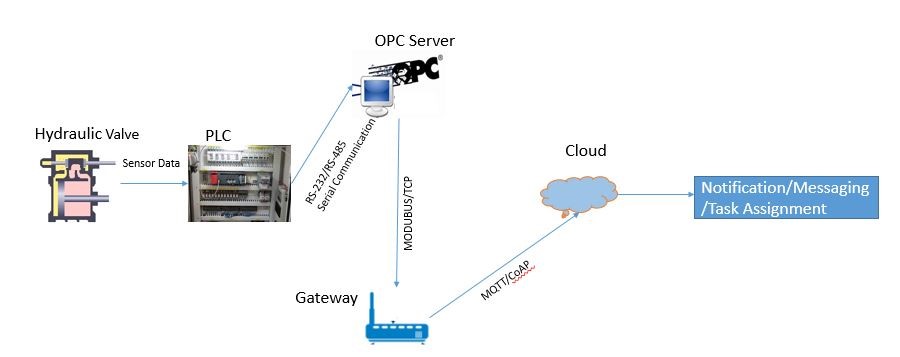With the rapid increase in competition, consumer demands, and industrial automation, manufacturing units around the world are compelled to adopt newer technological innovations and digital transformation solutions to be not left behind by the next big development in their sectors.
Common challenges faced by traditional industries
- Usage of the legacy devices and systems that pose problems in many aspects like an increase in manufacturing costs, time, and manpower, limited fault detection, increase in maintenance, and improper data analysis.
- Analysis of these legacy machines and devices is tough due to their complex fault detection and maintenance procedure, which is generally a time-constrained task.
- Data analysis is another issue across several industries. There is no such mechanism that can provide the production details of each device and machine periodically.
- Extraction of important inputs from components like turbines, valves, motors, pumps, etc. is also a challenging part.
- Difficulty in integrating systems for effective communications and co-ordination which ultimately lead to delayed processes.
- Problems in identification of faults, errors, and failures of machines, increasing production losses.
To deal with these challenges, most of the manufacturing units and industries are adopting Industry 4.0 practices. The manufacturing units are embedded with connected devices and networks, sensors and machines (for m2m communication), artificial intelligence, robots, etc. to enable smart processes and effectiveness in the overall manufacturing functions.
What is Industry 4.0?
Industry 4.0 is the fourth industrial revolution that is set to reshape the manufacturing and production industry by integrating digitization trends and technologies with industrial processes. It is a convergence of factory operations with technological innovations such as the Internet of Things, Robots, Predictive Analytics, Cloud Computing, and much more.
Industry 4.0 promotes a combination of connected machines, process automation, and manufacturing units. In that, the manufacturing model consists of the production of a physical entity with the help of end-to-end digitization, internal connected network, manpower for supervision, robots for automation of many critical functions, sensors, valves, actuators, PLC system, SCADA, communication protocols, connectivity to the cloud, IoT, and cyber security.
In summarization, the Industry 4.0 is a combination of some of these main aspects:
- Smart Factory Components: Embedded system, smart sub-systems, and connection protocols.
- Smart Machines: Intelligent machines or automated machines with minimal human efforts.
- Digital Factory: Smart systems in factories with complete digitized functionality.
- Connected Factory: Multiple factories connected to each other through the cloud.
- Smart Supply Chain: Digitized inventory management, dashboards for suppliers and customers.
Embrace #Industry4.0 to enable #smartfactory and #connectedmanufacturing via @einfochipsltd
What are the key components of Industry 4.0?
Industry 4.0 consists of many machines, components, and connection protocols:
- Sensors: There are different types of sensors that are installed in different systems for real-time data analysis and remote control of the operations like temperature sensor, humidity sensor, leak detection, pressure sensor, position sensor, accelerometers, etc.
- Valves and Actuators: These are the components responsible for controlling the passive processes of an industry like air and liquid flow. For example, pumps, motors, pneumatic valves, hydraulic valves etc.
- PLC System (Programmable Logic Controller): It is the heart of any industry that consists of the control of many industrial processes after getting input responses from devices and sensors. PLC is a programmable, sequential coding structure in the form of leader that consists of the process sequence of many events like lifts movement, turbine rotation, motor on/off, functionality of pumps, alarms, etc.
- SCADA (Supervisory control and data acquisition): These systems are used mostly in industrial organizations, companies, public & private sectors to control the efficiency of resources and maintain the backbone of many modern industries, especially in energy sectors, oil and gas, road & transportation, food and beverages, power grid, water/waste water, manufacturing, recycling, air & sea transportation, home automation’s, etc.
- OPC Server: The OPC (Object Linking and Embedding for Process Control) server for Modbus is the bridge between machines, devices, and IoT Gateway. It connects all legacy devices to the gateway or cloud for secure data storage and analysis.
- IoT Gateway: IoT gateway enables connectivity over cloud and data analysis.
- AR (Augmented reality) / VR (Virtual Reality): Adoption of these technologies in industrial environment helps field workers to troubleshoot any failure and faults in minimal time period.
- Improves worker safety to increase efficiency.
- VR collects behavioral user data during VR experiences and utilizes this data together with traditional data warehouse information.
- AR shortens the development cycle.
- AR helps in decreasing planning times and improves the quality of the planning.
- Reduces requirement of complete modeling of the production system.
HANDPICKED RELATED CONTENT
Catching up with Latest Trends in Industrial Automation – Machine Vision
How does an industrial IoT system work?
- Data from machines, sensors, and valves are captured by PLC or RTU (Remote Terminal Unit) and gets routed to the HMI computer.
- This data is transferred to OPC server from a PLC via serial protocols like RS-232 and RS-485 serial buses.
- Then data from OPC server is transferred to IoT Gateway through the MODBUS/TCP protocol for further analysis and storage to the cloud.
- Data can be also transferred directly to the user on a smart device application for instantaneous communication.
- MQTT (MQ Telemetry Transport) /CoAP (Constrained Application Protocol) messaging protocol establishes communication between gateways and cloud for data transfer.
Adopt #Industry4.0 to convert legacy components in your factory into smart and #connectedsystems via @einfochipsltd
Let’s take a process example of an Industrial Hydraulic Valve
The Hydraulic Valve controls the flow of liquid or oil in the industries. Depending on the position of spool direction, the flow rate is being altered. Controlling the spool position is a key to acquiring the required flow.
Position sensors are used for detecting the actual state of the spool. Apart from this, flow sensors are used for detecting the flow so the liquid flow can be controlled according to the requirement. The data from the sensors are captured by PLC controller for the controlled mechanism of the valve.
From the industry 4.0 perspective, the legacy device’s (PLC controller) data are then transferred to the OPC server through RS-232/RS-485 serial communication. Next, the data from OPC servers gets routed to the gateway through MODBUS, and from the gateway to cloud through MQTT.
That’s how the PLC controller is connected to the gateway and cloud. This connectivity to the gateway is important, which allows edge computing and analytics that gives the real-time control on the legacy devices.

How eInfochips’s Mesh Networking concept enables low latency Edge and Fog Analytics in Industry 4.0?
Consider a particular industry unit that has many gateways working at various parts due to a number of smart devices and machines. All these gateways are connected to each other by forming a mesh network and enable a peer-to-peer communication. Gateways situated nearby or Geo- correlated gateways can be pre-configured as a cluster of gateways that can solve the issue of IT/OT Convergence.
This clustering enables distributed edge analytics. The distributed edge nodes allow processing of data at the edge before transferring it to the cloud. This reduces latency. The edge-filtered data can be sent to the fog node or cloud directly for post-event processing. Further, the individual cluster creates a fog node, and a combination of fog nodes allow distributed fog computing. It gives the benefit of fast and real-time data analysis in any large industrial area, enabling faster fault response time.
HANDPICKED RELATED CONTENT
Industrial Internet of Things (IoT): Embracing a Revolution with IIoT!
Connected plants and their benefits in Industry 4.0
In a large industry, there are multiple plants or factories working on heterogeneous processes. Smart factory enables digitization of these factories by the adoption of smart devices and machines and connecting them remotely to the cloud. LPWAN (Low-Power Wide-Area Network) protocols are being used for connecting these factories and data generated from each factory is routed to a universal gateway for cloud connectivity and easy user access for analyzing the working status of plants. Digitized factories give benefit in real-time, efficiency analysis of production and manufacturing activities at the user end.
Why should industries transition to Industry 4.0 paradigm?
- Industry 4.0 enables predictive maintenance that reduces the MTTR (Mean Time to Repair) of components and machines.
- Predictive maintenance reduces the downtime of the plants by enabling the easy access and detection of faults and reduction in the repairing time.
- The transition of legacy devices into smart devices helps in the analysis of critical data like frequency, gross efficiency, heat rate, turbine speed, pressure ratio, exhaust Mass flow, exhaust temperature, emissions, vibrations etc.
- Edge analytics help in faster response on the occurrence of faults.
- Cloud integration gives benefits like user dashboarding for the analysis of fault logs and the pattern of faults, Responsive user interface (UI) for web and mobile, and auto job assignment via Email, Call & SMS.
- IoT Protocol gateway allows you to easily communicate with the multiple legacy devices/PLCs through MODBUS/TCP.
HANDPICKED RELATED CONTENT
Conclusion
Considering the above discussion about Industry 4.0 benefits, it is now necessary for every industry model to adopt the new technologies and transit their legacy devices into smart devices.
eInfochips is helping many industry verticals in Smart transitions and in developing analytical and engineering solutions for domains like Industrial Automation, Energy Generation Equipment, and Actuation Systems.













